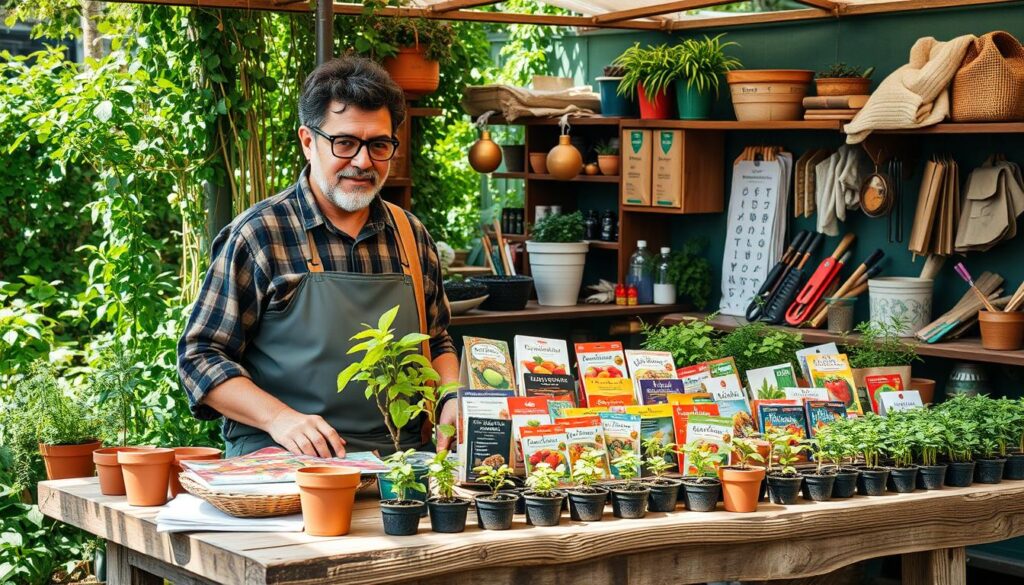“how to be self employed seed seller“Imagine starting with just $100 and turning it into a booming business. Becoming a self-employed seed seller is a great way to do this. You can start with a small investment of $300 to $1,000 and enter a market that’s growing fast.
This market is all about selling seeds, which are in high demand. It’s perfect for those who love gardening and want to live sustainably. One eBay seller made over $1 million selling seeds, showing how profitable it can be.
They sold 37,620 Cherokee Purple Tomato Seeds for $49,909.92, starting with just $100. They also bought seeds in bulk on Amazon and sold them again. This shows the potential for making a lot of money in the seed selling business.
In this guide, we’ll show you how to start a seed selling business from home. It’s great for a side job or a full-time business. The seed selling industry is a chance to make money while doing something you love.
Understanding the Seed Business Opportunity
The seed business is a great chance for new entrepreneurs. More people are gardening, farming in cities, and caring for the planet. This means there’s a big demand for seeds, like vegetables, flowers, herbs, and rare types.
Current Market Demand and Growth Potential
The global seed market is expected to grow fast, with a rate of over 8% each year. This growth comes from more people gardening at home, wanting unique seeds, and focusing on food safety. Smart entrepreneurs can make a lot of money by starting a seed business.
Investment Requirements and ROI Expectations
Starting a seed business doesn’t cost much, with initial costs around $300. The profit can be huge, sometimes over 1000% for certain seeds. By choosing the right seeds and running your business well, you can make a lot of money.
Legal Requirements and Licensing
To run a seed business, you must follow state and federal laws. This includes getting the right licenses, registering your business, and following rules for packaging and labeling. While it might seem hard, following these rules is key to your business’s success and trustworthiness.

How to Be Self Employed Seed Seller: Essential Steps
If you want to sell seeds on your own, there are key steps to follow. First, find out what seeds are most wanted in your area. This lets you stock up on seeds that people really want.
Next, find good wholesale seed suppliers. Good relationships with these suppliers mean you get quality seeds regularly. This makes your customers happy and keeps them coming back.
- Research popular seed varieties
- Identify reliable wholesale seed suppliers
- Establish packaging and shipping systems
- Create online store profiles on various platforms
- Develop pricing strategies and a marketing plan
Start by selling seeds that sell fast, like tomatoes and cucumbers. This helps you make money and get known in the market. As you grow, you can offer more seeds to meet your customers’ changing needs.

It’s also important to set up good packaging and shipping. Use professional packaging and find cheap shipping ways. This makes sure your seeds get to customers in great shape.
Make your seeds easy to find by setting up online stores. Use websites, social media, and marketplaces. This helps more people find and buy your seeds, building a loyal customer base.
Lastly, create a solid marketing plan. Use SEO, social media, emails, and more to draw in and keep customers. This is key to making your seed selling business a success.
By taking these steps, you can become a successful seed seller. You’ll tap into the growing demand for quality seeds and support local, sustainable farming.
Sourcing and Managing Seed Inventory
As a self-employed seed seller, managing your seed inventory well is key to your success. You need to work with trusted wholesale seed suppliers. Also, use strong inventory management systems and strict quality control measures. This ensures your customers get the best seeds.
Wholesale Seed Suppliers and Partnerships
Finding reliable wholesale seed suppliers is vital. Companies like Mountain Valley Seed Company and Outside Pride are great choices. They focus on sustainable farming and offer top seed varieties. Working with them helps keep your inventory diverse and of high quality.
Inventory Management Systems
A good seed inventory management system is crucial. It helps track seed amounts, expiration dates, and sales. This way, you can manage your inventory better and avoid waste. Tools for managing farm inventory have been a game-changer for many, and can be for you too.
Quality Control Measures
Keeping your seed inventory quality high is essential. This means storing seeds right, testing germination, and labeling correctly. By doing this, you ensure your customers get seeds that will grow well.
Working with top wholesale seed suppliers, using effective inventory management systems, and focusing on quality control are key. These steps help you manage a successful seed inventory as a self-employed seed seller.
| Benefit | Description |
|---|---|
| Reduced Costs | Farm inventory management tools have helped small and mid-sized farms cut costs and increase efficiency in recent years. |
| Improved Efficiency | Tracking farm inventory is crucial for driving growth and optimizing production, shipment, and storage of goods, especially for perishable goods. |
| Enhanced Decision-Making | Taking advantage of data and reports generated by farm-specific POS and inventory management software allows for quantifiable insights into farming operations. |
Setting Up Your Online Presence
To succeed in online seed sales, you need a strong online presence. This means picking a good domain name, finding reliable web hosting, and setting up accounts on big e-commerce sites like eBay, Etsy, and Amazon.
For your domain and hosting, NameCheap is a great choice. They offer affordable, easy-to-use options for a professional online seed store. With 24/7 support and customizable features, your site will look great and work well for customers.
Using big e-commerce sites also helps you reach more customers. These platforms make it easy to start an online seed business. They handle inventory, payments, and analytics for you. Selling on different sites helps you reach more people.
It’s important to have a consistent brand everywhere, including social media. Talk to your customers, share useful info, and show your knowledge. This makes your brand trustworthy and reliable in the seed world.
To succeed, focus on making your online store easy for customers to use. Keep improving your site, watch your numbers, and stay up with new trends. This will help your business grow and stay competitive.
| Platform | Advantages | Considerations |
|---|---|---|
| eBay |
|
|
| Etsy |
|
|
| Amazon |
|
|
Packaging and Shipping Operations
Starting your own seed selling business? You need to focus on packaging and shipping. This is key for your success. We’ll look at how to pack seeds well and ship them affordably.
Professional Packaging Solutions
Using top-notch, eco-friendly packaging is vital. It keeps your seeds safe and makes your customers happy. Choose materials like brown kraft paper seed packages and clear cellophane bags for protection and display.
Adding your logo to the packaging boosts your brand. It leaves a lasting impression on your customers.
Shipping Methods and Cost Management
Choosing the right shipping depends on your order size and value. For small orders under $10, simple envelopes might do. But for bigger orders, use bubble mailers and tracking services for safety.
Compare different shipping options to save money. Find the best balance between cost and reliability for your customers.
Storage Requirements
Keeping seeds in good condition is essential. You need the right storage to keep them cool and dry. This might mean investing in climate-controlled storage facilities or using desiccant packs.
Good storage means you can offer the best seeds. This helps your customers succeed in gardening.
| Packaging Solution | Shipping Method | Storage Requirement |
|---|---|---|
|
|
|
By using theseseed packaging solutions,shipping methods, andstorage requirements, you can make your business run smoothly. This ensures your products are of high quality and your customers have a great experience.
Marketing Strategies for Seed Sales
As a self-employed seed seller, your success depends on marketing your products well. Using smart seed marketing strategies can attract and keep loyal customers. This drives growth for your seed business. Let’s look at some effective marketing ways to increase your seed sales:
Leverage Social Media
Use Facebook, Instagram, and Twitter to show off your seeds and share growing tips. Regular posts can build your brand and create a gardening community.
Optimize Product Listings
Make your online listings easy to find by using the right keywords and detailed descriptions. High-quality images also help your seeds stand out.
Offer Seasonal Promotions
- Use seasonal trends for promotions, like seed bundles for spring or discounts on specialty varieties.
- Seasonal marketing creates urgency and excitement, encouraging customers to buy more seeds.
Build an Email List
Get email addresses from customers and create a mailing list. Send newsletters with tips, updates, and special offers. This keeps your brand in mind and encourages repeat business.
Highlight Unique Varieties
Showcase rare or unique seed varieties’ special features and benefits. This attracts niche markets and sets you apart from competitors.
| Marketing Tactic | Description | Key Benefits |
|---|---|---|
| Social Media Engagement | Actively posting on platforms like Facebook, Instagram, and Twitter to build brand awareness and connect with customers. | Increased visibility, customer engagement, and potential for viral content sharing. |
| Search Engine Optimization | Optimizing product listings and website content with relevant keywords to improve search engine rankings. | Higher visibility in search results, leading to more qualified traffic and potential sales. |
| Email Marketing | Building an email list and sending newsletters with growing tips, product updates, and exclusive offers. | Retaining customers, driving repeat business, and fostering a loyal customer base. |
| Unique Variety Promotion | Highlighting the distinctive features and benefits of rare or specialty seed varieties. | Attracting niche markets, differentiating from competitors, and commanding premium pricing. |
By using these seed marketing strategies, you can promote your seed business well. This helps you reach more people and grow your self-employed seed selling business.
Building a Profitable Product Line
As a self-employed seed seller, it’s key to have a profitable product line. Choosing the right profitable seed varieties, setting smart seed pricing strategies, and planning for seasonal seed planning are crucial. These steps can make your seed business thrive and last.
Popular Seed Varieties Selection
Identifying the most wanted seed varieties is vital. Some top popular and profitable seed options are:
- Cherokee Purple Tomato
- Yellow Granex PRR F1 (Vidalia Onion)
- Wildflower mixes
Pricing Strategies
Setting the right seed pricing is crucial. Look at competitor prices, packaging costs, and your profit goals. Selling 30-seed packs for $3.98 to $10 is a common method, based on the variety.
Using absorption pricing (cost + profit) and competitor-based pricing (matching similar products’ prices) can help you price well.
Seasonal Planning
Good seasonal seed planning ensures you have the right seeds all year. Stock seeds for upcoming seasons and adjust based on past sales.
By knowing seasonal trends and what customers want, you can improve your product line. This boosts profits in all seasons.
| Seed Variety | Pricing (30-seed pack) | Profit Margin |
|---|---|---|
| Cherokee Purple Tomato | $5.98 | 40% |
| Yellow Granex PRR F1 (Vidalia Onion) | $7.99 | 45% |
| Wildflower Mix | $3.98 | 35% |
Financial Management and Growth Planning
Being a seed seller means you need to manage your finances well. Keep an eye on what you spend on seeds, how much you make, and your other costs. This helps you decide how to use your profits to grow your business.
Think about selling more than just seeds. You could sell gardening tools or special seed collections. As your business gets bigger, you might create new seeds or work with local farmers. This way, you can meet more customers’ needs and stay ahead in the market.
| Key Financial Management Strategies | Benefits |
|---|---|
|
|
Use strong seed business financial management and look for ways to scale your seed business. This will set your business up for lasting success and growth.
Conclusion
Starting a seed business as your own boss is a great way to enter the world of agriculture and gardening. Choose popular seed types, work efficiently, and market well. Also, make sure your customer service is top-notch. This will help your seed business grow and make money over time.
As your business grows, you might want to reach more people in the gardening world. This could turn your small seed business into a big company. Knowing the seed industry well, focusing on quality, and planning ahead are key. This way, you can become a successful seed entrepreneur and help grow the seed business scene.
This guide has shown you how to turn your love for seeds into a job that lasts. Success comes from being open to change, always improving what you offer, and listening to what your customers need. Start this journey and watch your seed business thrive.
FAQ
What are the startup costs for a self-employed seed selling business?
What are the startup costs for a self-employed seed selling business?
FAQ
What are the startup costs for a self-employed seed selling business?
Starting a seed selling business can cost between 0 and
FAQ
What are the startup costs for a self-employed seed selling business?
Starting a seed selling business can cost between $300 and $1,000. This depends on the types and amounts of seeds you plan to sell.
What is the profit potential for a seed selling business?
A seed selling business can be very profitable. Some sellers make up to $50,000 from just $100. This is because seeds are cheap to buy in bulk and can be sold at higher prices.
What are the legal requirements for selling seeds?
To sell seeds, you might need licenses and must follow state and federal laws. It’s key to check and follow all laws in your area.
Where can I find reliable wholesale seed suppliers?
Good suppliers for seeds include Mountain Valley Seed Company and Outside Pride. Working with trusted suppliers helps keep your seed quality and variety high.
How do I set up an online presence for my seed business?
To start online, pick a domain name, get hosting, and open accounts on eBay, Etsy, and Amazon. Also, use social media to build your brand and connect with customers.
What are the best seed varieties to sell?
Popular seeds to sell are Cherokee Purple Tomatoes, Yellow Granex PRR F1 (Vidalia Onion), and wildflower mixes. Selling unique seeds can also attract specific customers.
How should I price my seed products?
Price your seeds at $3.98 to $10 for 30-seed packs. Consider what others charge, your costs, and how much profit you want to make.
How can I effectively market my seed business?
Use social media, make your listings easy to find, run seasonal sales, and build an email list. Give detailed growing advice to keep customers coming back.
,000. This depends on the types and amounts of seeds you plan to sell.
What is the profit potential for a seed selling business?
A seed selling business can be very profitable. Some sellers make up to ,000 from just 0. This is because seeds are cheap to buy in bulk and can be sold at higher prices.
What are the legal requirements for selling seeds?
To sell seeds, you might need licenses and must follow state and federal laws. It’s key to check and follow all laws in your area.
Where can I find reliable wholesale seed suppliers?
Good suppliers for seeds include Mountain Valley Seed Company and Outside Pride. Working with trusted suppliers helps keep your seed quality and variety high.
How do I set up an online presence for my seed business?
To start online, pick a domain name, get hosting, and open accounts on eBay, Etsy, and Amazon. Also, use social media to build your brand and connect with customers.
What are the best seed varieties to sell?
Popular seeds to sell are Cherokee Purple Tomatoes, Yellow Granex PRR F1 (Vidalia Onion), and wildflower mixes. Selling unique seeds can also attract specific customers.
How should I price my seed products?
Price your seeds at .98 to for 30-seed packs. Consider what others charge, your costs, and how much profit you want to make.
How can I effectively market my seed business?
Use social media, make your listings easy to find, run seasonal sales, and build an email list. Give detailed growing advice to keep customers coming back.

 For the past 5 years, I've been obsessed with the power of words and how they can help businesses like yours thrive online.
For the past 5 years, I've been obsessed with the power of words and how they can help businesses like yours thrive online.